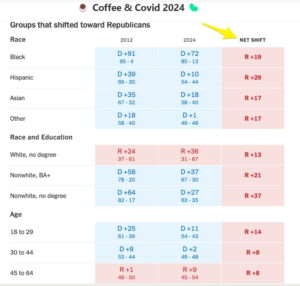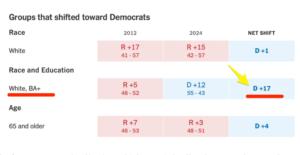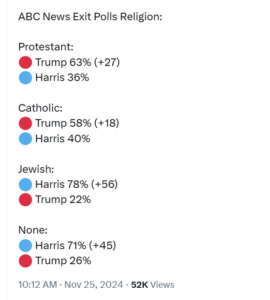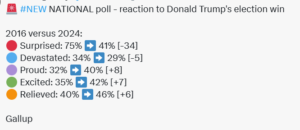A POST ELECTION ANALYSIS FOR THE AGES
The Brilliant Jeff Childers has penned THE best analysis of the 2024 Presidential Election you are ever going to read :
I am copying it all here and will save it on the sidebar as a testimony to what has just happened …It’s a brilliant take complete with historical references that are realy eye opening. Send this around. If any piece will bring Middle Lefties to an understanding of what just happened in reference to historical norms…this is IT .
……………….
The New York Times ran (another) deep post-election analysis over the weekend headlined, “How Democrats Lost Their Base and Their Message.” It described what is gaining speed to potentially become the Democrats’ worst-case scenario.
The article began by contrasting Trump’s 2016 and 2024 strategies. In 2016, Trump won using an electoral “Moneyball” approach, surprising Democrats by gaming out exactly which handful of key counties were needed to win the Electoral College. The 2020 election proved the Democrats learned their lesson and weren’t about to let Republicans win again through cherry-picking.
During his 2020-2024 wilderness years, amidst fending off FBI raids and a mudslide of political lawfare persecution, President Trump discarded wonky statistical manipulation. Instead, he leaned into his roots, his undeniable genius: marketing. The new strategy was not to win through statistical sleight of hand but by actually selling Americans on a better vision, a vision of a better America that was and an even better America that once again could be.
Make America Great Again. It was pure marketing genius.
Only President Trump could have done it, and that is because he is quintessentially American: part P.T. Barnum, part Teddy Roosevelt, part Abraham Lincoln.
Commonly referred to as a “master showman,” P.T. Barnum was a genius of spectacle and self-promotion. Like Trump, Barnum enjoyed an uncanny ability to captivate audiences, transform controversies into publicity, and consistently manifest a larger-than-life persona. Like Trump, Barnum built his fortune in Manhattan
Like Trump, President Teddy Roosevelt (1901-1909), who coined “speak softly and carry a big stick,” was also a dynamic, larger-than-life figure, beloved for his populism, rugged individualism, and his feisty, combative spirit. He shattered political norms and redefined the GOP for a generation, delivering a “Square Deal” for America by waging war on the entrenched power structures of the day, especially big corporations (the “trusts”). Teddy was a strong Republican leader, but he shattered political norms by embracing the working class through his trust-busting, anti-corporate, and consumer protection policies.
Finally, Trump is easily compared to President Abraham Lincoln (1861-1864), who is regularly ranked as the nation’s greatest president by presidential historians. Like Trump, Lincoln was (and remains) deeply divisive. Democrats in 1860 were so enraged at the election of the first Republican president that seven heavily Democrat southern states quickly seceded between Lincoln’s election and his inauguration. They didn’t even wait for Lincoln to take the oath to see what he would do.
You could call it Lincoln Derangement Syndrome (LDS). And, of course, they shot both Lincoln and Trump in the head after each president’s first term.
There are many points of similarity, but here’s just one more: like Trump, Lincoln was also elected through a unique confluence of electoral events: a disunited Democrat party shattered into three competing candidates, paving the way for the first Republican to be elected president in the nation’s history.
I am not arguing Trump is just like these three great American men, not at all. President Trump is a unique modern amalgam of their circumstances and their best, quintessentially American qualities.
? Regardless, during his presidential interregnum, master marketer Trump undertook to give the GOP a much-overdue brand refresh. He hawked conservatism to core parts of the Democrat base, the parts that don’t enjoy full membership benefits enjoyed by that party’s elite ruling class.
But … was it a re-brand? Or did Trump, like Teddy Roosevelt did, shift the GOP from an off-skew slant back toward its home base?
Trump’s success at communicating with discarded, disenfranchised Democrats is undeniable. Consider this chart from the New York Times’s analysis, calculating the 12-year shift toward the GOP:
In other words, men and women included, Trump gained with: young people, working-aged folks, college-educated minorities, black folks, Hispanics, Asians, all “other race” people, and working-class whites.
Now consider this: These gainers are all folks who would have voted for President Lincoln in 1860. Think about what that implies.
It got better. The next chart in the Times’s analysis showed the paltry three groups that improved for Democrats—the demographics that shifted away from Trump’s populism—and one group in particular stuck out like monkeypox:
The first outrageous implication, which I won’t dwell on because why pout about things you can’t change, is that if it had gone the other way, had Republicans only gained with over-educated whites, the New York Times would be jumping up and down shouting “white supremacy!!” from the skyrises.
But which party is actually, by the numbers, the party of “white supremacy?” Trump exposed the Democrats. The only group who solidly slid away from Trump’s populist MAGA movement was college-educated whites. Insufferable, pasty-skinned, wealthy coastal elites.
In other words, the same people who would have voted Democrat in 1860.
Nothing has changed! Nothing about Democrats has changed except, for a long time, the Democrats were able to fool minorities and working-class whites into thinking they’d abandoned their elitist, slave-owning roots. They tricked the same groups that, down south, the Democrats had consistently fooled before the Civil War.
But the Democrats have not, in fact, changed. The numbers prove it, and the Times’s analysis agreed. “Democrats,” the article explained, “became the party of institutions, the national security apparatus, norms and, ultimately, the status quo — not change.”
Pre-Civil War, the Southern Democrats were institutionalists. They even euphemistically called slavery their “peculiar institution.” Southern Democrats argued for preservation of the status quo. Southern Democrats claimed entitlement to enforcement of their elite norms.
The factors the Times attributed to Democrats’ landslide loss in the recent election were also true of Democrats in 1860.
Master marketer Trump was able to, at least partly, rip off the Democrats’ creaky, 150-year-old mask of deceit. As a result, Trump’s near-orbit is crowded with former Democrats like Elon Musk, Tulsi Gabbard, and Robert Kennedy, Jr.
? Which brings us to the really bad news for Democrats. Unlike Trump’s 2016 victory, this time his win signals a problem far beyond brilliant electoral gamesmanship. This time, Trump’s win signals a permanent shift in voter preferences.
Democrats never saw it coming.
“This pattern,” the Times glumly admitted, “has no modern precedent. It suggests that the backlash against Democrats during 2021 and 2022 affected the political allegiance of millions of voters — and ultimately the electoral map.”
In other words, MAGA is not a historical blip. It is a trend.
“Mr. Trump,” the Times continued, “flipped all of it around, weakening Democrats’ bonds with working-class voters, as well as nonwhite and young ones.” Trump’s victory “has shattered Democratic dreams of building a new majority with the rise of a new generation of young and nonwhite voters.”
More than made-up fears the dark night of fascism has finally landed on the United States instead of on Europe, this, more than anything else, is what truly terrifies and deeply discombobulates the Democrats. The Democrat party’s brand has reverted to the brand of big institutions, of aggressive preservation of elite norms, of sneering, arrogant academics and wealthy, slave-holding authoritarianism.
They’ve been Bud-Lited. And because it is true, it will be next to impossible for the Democrats to shed their authentic brand without the kind of fundamental transformation that their current ossified, geriatric leaders are institutionally unable to effect.
? It reminds me of my lawsuit against a municipal “vaccinate or terminate” mandate that I successfully stopped in 2021. In their brief, the city’s lawyers invoked George Washington’s smallpox inoculation mandate during the Revolutionary War. If it’s good enough for the Father of the Country, they argued, it’s good enough for us.
But at the hearing on my motion to enjoin the mandate, I turned their Father of the Country argument around on them. With the greatest respect, and not applying modern values in hindsight, I delicately pointed out that George Washington owned slaves.
In other words, long before the Constitution, George Washington considered people to be property, the equivalent of a herd of cattle, to be vaccinated in herds at their owner’s inclination, regardless of the property’s own desires.
I explained to the judge that, like George Washington, the city considered its employees to be property. Municipal employees were just a cattle-like herd to be immunized solely because the paternalistic city thought best.
The judge got it.
Looking back, it seems obvious that the mad scramble to respond to the pandemic’s “emergency” forced Democrats to assume the position they’ve always secretly held since before the Civil War: elite owners of human property, us, the dumb cows who’d witlessly die of smallpox unless the herd was corraled and given its shots.
Vaccine mandates are the slave owners’ prerogative.
And so President Trump successfully surfed the tide of resentment at Democrats’ arrogant elitism and authoritarianism, riding the momentum to expose them at each grotesque level of their institutional incompetence.
? CODA: A large section of the Times’s analysis of Democrat woes, the way they were ultimately exposed, was correctly ascribed to the authoritarian excesses of the pandemic. “Activists, academics and experts,” the Times dolefully explained, “pushed a sweeping response, from school shutdowns and mask mandates to diversity statements in hiring.”
The article failed to mention the giant human cockroach in the room: vaccine mandates. But the sound of their insectile legs could be distinctly heard scuttling throughout the Times’s analysis. Sow the wind, and reap the whirlwind.
In short, paradoxically, the great suffering of the pandemic looks like one more thing for which we should be thankful this week.
Polls Nov 24 ’24






“Vaccine mandates are the slave owners’ prerogative.”
Interesting parallel.
“And so President Trump successfully surfed the tide of resentment at Democrats’ arrogant elitism and authoritarianism, riding the momentum to expose them at each grotesque level of their institutional incompetence.”
For many, yes.